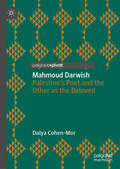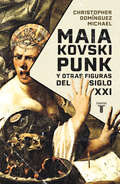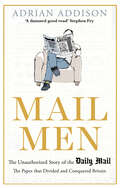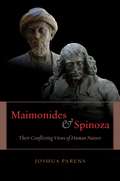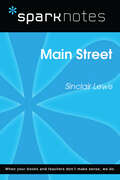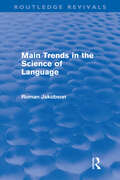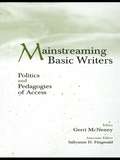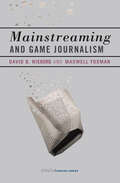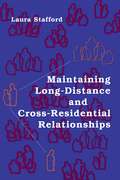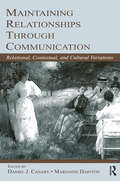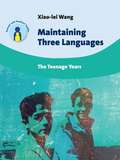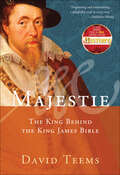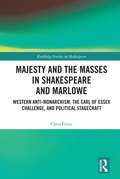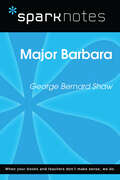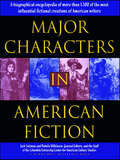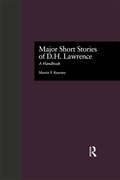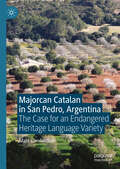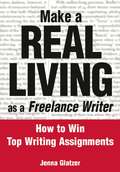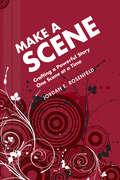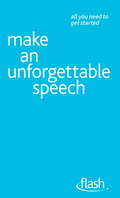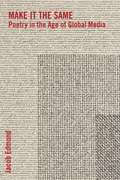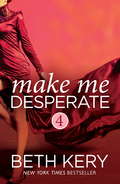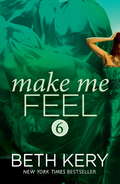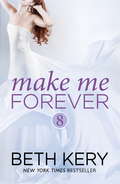- Table View
- List View
Mahmoud Darwish: Palestine’s Poet and the Other as the Beloved
by Dalya Cohen-MorMahmoud Darwish: Palestine’s Poet and the Other as the Beloved focuses on Palestinian national poet Mahmoud Darwish (1941–2008), whose poetry has helped to shape Palestinian identity and foster Palestinian culture through many decades of the Israeli-Palestinian conflict. Dalya Cohen-Mor explores the poet’s romantic relationship with “Rita,” an Israeli Jewish woman whom he had met in Haifa in his early twenties and to whom he had dedicated a series of love poems and prose passages, among them the iconic poem “Rita and the Gun.” Interwoven with biographical details and diverse documentary materials, this exploration reveals a fascinating facet in the poet’s personality, his self-definition, and his attitude toward the Israeli other. Comprising a close reading of Darwish’s love poems, coupled with many examples of novels and short stories from both Arabic and Hebrew fiction that deal with Arab-Jewish love stories, this book delves into the complexity of Arab-Jewish relations and shows how romance can blossom across ethno-religious lines and how politics all too often destroys it.
Maiakovski punk y otras figuras del siglo XXI
by Christopher Domínguez MichaelUna revisión crítica a la obra de los escritores más representativos de lo que va del siglo XXI. A El XXI en el XXI (2011) y La sabiduría sin promesa. Vida y letras del siglo xx (2001 y 2009), se suma Maiakovski punk y otras figuras del siglo XXI, donde Christopher Domínguez Michael continúa su examen de la literatura moderna. Extendiéndose a la centuria en curso, en este libro tenemos sus ensayos y artículos que van desde la lamentación por las ruinas de Palmira hasta las consecuencias de la “intervención” en la obra de Borges, pasando por una radiografía posmoderna del ateísmo proclamado por Hitchens y Onfray, la criminal inverecundia de Handke, la reposición de Camus realizada por Kamel Daoud, el neogótico rockero de Mariana Enriquez, la lucrativa farsa del llamado Arte Contemporáneo, el retorno de los apocalípticos en pantuflas como Agamben y Cía., la literatura en estado de peste y pandemia, y siguiendo a Michiko Kakutani, leemos, asimismo, cómo la posverdad pasó del gramatólogo Derrida al presidente Trump y miramos a la Ucrania en guerra, el solar de Bábel y Bulgákov. Pese a darle prioridad a las obras impresas en estos casi veinticinco años de la nueva centuria, Maiakovski punk y otras figuras del siglo xxi también recoge comentarios sobre novelas, cuentos, ensayos y poemas de Benedetti, Piglia, Fumaroli, Parra, Christa Wolf, Oscar del Barco, Lowell, Zurita o Vila-Matas, mostrando una vez más cómo la erudición, el humor, la acritud y la intransigencia frente a modas e ideologías, han hecho de Domínguez Michael uno de los críticos literarios más polémicos y cosmopolitas de nuestra lengua. Los críticos nos dicen «“Pues no sigas leyendo por ahora a Domínguez Michael”, me decía mi mujer, viendo que me desvelaba, como cuando me ve leer a Bloom o a Steiner. No era igual. Mi reacción no era polémica o en contra. Lo que sentía es que algo muy profundo (de los latinoamericanos) se estaba dilucidando en lo que leía.» -Guillermo Sucre (1997) «Jamás he tenido la oportunidad de presenciar, reconocer, discutir en mi interior, oponerme a ella o estremecerme con la obra de un crítico absoluto. Este privilegio materializado en mi lengua y en América me ha acompañado durante años. Deriva de los libros de Domínguez Michael, que se convierten en el renacimiento del pensamiento literario.» -José Balza (2012)
Mail Men: The Unauthorized Story of the Daily Mail
by Adrian AddisonDiscover the secret history of the paper that has shaped Britain and taken over the world. Perhaps because of the power and fear that the Daily Mail commands, this is the first book to provide an unauthorized account of the newspaper with more global readers than any other. With a gripping personality-led narrative, informed by sources near the top of the paper, Mail Men investigates the secret behind the Mail's extraordinary longevity and commercial success. But, it also examines the controversies that have beset the paper—from its owner's flirtation with fascism in the 1930s to its fractious relationship with liberals, celebrities and politicians today. Asking why the Mail attracts such anger around the world, Addison explores how insiders view the furore the paper creates both in its print and online incarnation. He also uses his numerous contacts to ask how the paper has stayed relevant for over a century. How has MailOnline built such a huge global audience by focussing on celebrity gossip, in apparent tension with the sometimes puritanical values of its sister print edition? Gripping and revealing, this book gives a previously unseen insight into the colorful cast of senior MailMen (yes, nearly all men) who have molded the paper through the decades—from Alfred C. Harmsworth, the Mail's founder and first owner, a frenetic genius who invented the popular press as we know it, to Martin Clarke, the fearsome Scot who runs MailOnline, the most popular newspaper website in the world.
Maimonides and Spinoza: Their Conflicting Views of Human Nature
by Joshua ParensUntil the last century, it was generally agreed that Maimonides was a great defender of Judaism, and Spinoza--as an Enlightenment advocate for secularization--among its key opponents. However, a new scholarly consensus has recently emerged that the teachings of the two philosophers were in fact much closer than was previously thought. In his perceptive new book, Joshua Parens sets out to challenge the now predominant view of Maimonides as a protomodern forerunner to Spinoza--and to show that a chief reason to read Maimonides is in fact to gain distance from our progressively secularized worldview. Turning the focus from Spinoza's oft-analyzed Theologico-Political Treatise, this book has at its heart a nuanced analysis of his theory of human nature in the Ethics. Viewing this work in contrast to Maimonides's Guide of the Perplexed, it makes clear that Spinoza can no longer be thought of as the founder of modern Jewish identity, nor should Maimonides be thought of as having paved the way for a modern secular worldview. Maimonides and Spinoza dramatically revises our understanding of both philosophers.
Main Street (SparkNotes Literature Guide Series)
by SparkNotesMain Street (SparkNotes Literature Guide) by Sinclair Lewis Making the reading experience fun! Created by Harvard students for students everywhere, SparkNotes is a new breed of study guide: smarter, better, faster. Geared to what today's students need to know, SparkNotes provides: *Chapter-by-chapter analysis *Explanations of key themes, motifs, and symbols *A review quiz and essay topicsLively and accessible, these guides are perfect for late-night studying and writing papers
Main Trends in the Science of Language (Routledge Revivals)
by Roman JakobsonFirst published in Great Britain in 1973, Main Trends in the Science of Language was part of a series of books that resulted from a study carried out by UNESCO in collaboration with national and international research centres in the social sciences, as well as with groups of individual scholars. The book examines the position of linguistics in the years surrounding the publication of the book before considering the subject’s potential, future development. It looks at linguistic vistas, the place of linguistics among the sciences of man and linguistics and natural sciences. This book will be of interest to the educated reader, research workers, and professional associations as well as to national and international institutions that organize, plan and finance scientific research.
Mainstreaming Basic Writers: Politics and Pedagogies of Access
by Gerri McNenny Sallyanne H. FitzgeraldAt a time when various political and administrative bodies are calling for the dissolution of basic writing instruction on four-year college campuses, the need for information concerning the options available to university decision makers has become more and more pressing. A wide range of professional judgments surrounding this situation exits. Mainstreaming Basic Writers: Politics and Pedagogies of Access presents a range of positions taken in response to these recent challenges and offers alternative configurations for writing instruction that attempt to do justice to both students' needs and administrative constraints. Chapter authors include, for the most part, professionals entrusted with the role of advocating for a student population often described as "underprepared," "in need of remediation," and "at risk." Throughout the volume, contributors discuss current institutional developments and describe curricular designs that instructors searching for innovative ways to meet the needs of their heterogenous student populations will find helpful as models of college writing program curricula and administration. This book's focus is to give a fair representation of some of the more noted perspectives from nationally recognized scholars and administrators working in the field of basic writing. This presentation of key positions on the issue of mainstreaming basic writers at the college level is an important resource for all writing program administrators, composition and rhetoric students and scholars, and university decision makers from provosts to deans to department chairs.
Mainstreaming and Game Journalism (Playful Thinking)
by David B. Nieborg Maxwell FoxmanWhy games are still niche and not mainstream, and how journalism can help them gain cultural credibility.Mainstreaming and Game Journalism addresses both the history and current practice of game journalism, along with the roles writers and industry play in conveying that the medium is a &“mainstream&” form of entertainment. Through interviews with reporters, David B. Nieborg and Maxwell Foxman retrace how the game industry and journalists started a subcultural spiral in the 1980s that continues to this day. Digital play became increasingly exclusionary by appealing to niche audiences, relying on hardcore fans and favoring the male gamer stereotype. At the same time, this culture pushed journalists to the margins, leaving them toiling to find freelance gigs and deeply ambivalent about their profession.Mainstreaming and Game Journalism also examines the bumpy process of what we think of as &“mainstreaming.&” The authors argue that it encompasses three overlapping factors. First, for games to become mainstream, they need to become more ubiquitous through broader media coverage. Second, an increase in ludic literacy, or how-to play games, determines whether that greater visibility translates into accessibility. Third, the mainstreaming of games must gain cultural legitimacy. The fact that games are more visible does little if only a few people take them seriously or deem them worthy of attention. Ultimately, Mainstreaming and Game Journalism provocatively questions whether games ever will—or even should—gain widespread cultural acceptance.
Maintaining Long-Distance and Cross-Residential Relationships (Routledge Communication Series)
by Laura StaffordThis thought-provoking volume offers an innovative and intriguing approach to the study of long-distance relationships. Author Laura Stafford examines romantic long-distance relationships and then expands the conception of long-distance relationships to include other relational types. She summarizes literature across the social sciences on various types of long-distance relationships and extracts themes and patterns across the relational types. In so doing, she reconsiders approaches to and offers an expanded vision of relational maintenance.By expanding her scope beyond romantic relationships, Stafford includes those that span residences and relational types, such as noncustodial parent-child and geographically and residentially separated adult children and parents. She contends that face-to-face interaction is not necessary to maintain healthy relationships, and questions the assumption that maintaining, rather than terminating, a particular relationship is always best for the involved parties.With its interdisciplinary approach to challenging commonly held assumptions about communication and close relationships, Maintaining Long-Distance and Cross-Residential Relationships will be engaging reading for scholars in communication, psychology, sociology, mass communication, and family studies. It is also appropriate for special topics graduate courses on long-distance relationships and human communication, and will serve as a unique supplemental text for upper-level undergraduate and graduate students in interpersonal, relational, and family communication and family studies.
Maintaining Relationships Through Communication: Relational, Contextual, and Cultural Variations (LEA's Series on Personal Relationships)
by Daniel J. Canary Marianne DaintonRelational maintenance provides a rallying point for those seeking to discover the behaviors that individuals utilize to sustain their personal relationships. Theoretical models, research programs, and specific studies have examined how people in a variety of close relationships choose to define and maintain those relationships. In addition, relational maintenance turns our attention to communicative processes that help people sustain their close relationships. In this collection, editors Daniel J. Canary and Marianne Dainton focus on the communicative processes critical to the maintenance and enhancement of personal relationships. The volume considers variations in maintaining different types of personal relationships; structural constraints on relationship maintenance; and cultural variations in relational maintenance. Contributions to the volume cover a broad range of relational types, including romantic relationships, family relationships, long-distance relationships, workplace relationships, and Gay and Lesbian relationships, among others. Maintaining Relationships Through Communication: Relational, Contextual, and Cultural Variations synthesizes current research in relationship maintenance, emphasizes the ways that behaviors vary in their maintenance functions across relational contexts, discusses alternative explanations for maintaining relationships, and presents avenues for future research. As such, it is intended for students and scholars studying interpersonal communication and personal relationships.
Maintaining Three Languages
by Xiao-Lei WangThe teenage years are a fascinating time in the life of any family, but what happens when the challenges of parenting teenagers are combined with the desire to help your children build on their multilingual abilities? In this follow-up to Growing up with Three Languages: Birth to Eleven, Xiao-lei Wang offers a unique insight into the dynamics of a multilingual family. She combines practical, evidence-based advice with rich detail from observations of her own family to offer support and inspiration on an aspect of multilingual parenting that has received comparatively little attention. By placing language within the wider context of teenagers' cognitive and social development, this book will enable parents everywhere to help and guide their children through the next step in their multilingual journey.
Majestie: The King Behind the King James Bible
by David TeemsThe story behind the creation of the King James Bible and the king who made it happen: “Engrossing and entertaining . . . a delightful read in every way.” —Publishers WeeklyOrphaned, bullied, lonely, and unloved as a boy, in time the young King of Scots overcame his troubled beginnings to ascend the English throne at the height of England’s Golden Age. In an effort to pacify rising tensions in the Anglican Church, and to reflect the majesty of his new reign, he spearheaded the most important literary undertaking in Western history—the translation of the Bible into a beautiful, lyrical, and accessible English.David Teems’s narrative crackles with wit, using a thoroughly modern tongue to reanimate the life of this seventeenth-century king—a man at the intersection of political, literary, and religious thought, yet a man of contrasts, dubbed by one French king as “the wisest fool in Christendom.”Teems’s depiction of King James has all the elements of a grand tale—conspiracy, kidnapping, witchcraft, murder, love, despair, loss. Majestie offers an engaging new look at the world’s most cherished, revered, and influential translation of Sacred Writ and the king behind it.
Majesty and the Masses in Shakespeare and Marlowe: Western Anti-Monarchism, The Earl of Essex Challenge, and Political Stagecraft (Routledge Studies in Shakespeare)
by Chris FitterThis book is a landmark study of Shakespeare’s politics as revealed in his later History Plays. It offers the first ever survey of anti-monarchism in Western literature, history and philosophy, tracked from Hesiod and Homer through to contemporaries of Shakespeare such as George Buchanan and the authors of the Mirror for Magistrates, thus demonstrating that anxiety over monarchic power, and contemptuous demolitions of kingship as a disastrously irrational institution, formed an important and irremovable body of reflection in prestigious Western writing. Overturning the widespread assumption that "Elizabethans believed in divine right monarchy", it exposits the anti-monarchic critique built into Shakespeare’s Histories and Marlowe’s Massacre at Paris, in five chapters of close literary critical readings, paying innovative attention to performance values. Part Two focuses Queen Elizabeth’s principal challenger for national rule: the Earl of Essex, England’s most popular man. It demonstrates from detailed readings that, far from being an admirer of the war-crazed, unstable, bi-polar Essex, as is regularly asserted, Shakespeare launched in Richard II and Henry IV a campaign to puncture the reputation of the great earl, exposing him as a Machiavel seeking Elizabeth’s throne. Shakespeare emerges as a humane and clear-sighted critic of the follies intrinsic to dynastic monarchy: yet hostile, likewise, to the rash militarist, Essex, who would fling England into permanent war against Spain. Founded on an unprecedented and wide-ranging study of anti-monarchist thought, this book presents a significant contribution to Shakespeare and Marlowe criticism, studies of Tudor England, and the history of ideas.
Major Barbara (SparkNotes Literature Guide Series)
by SparkNotesMajor Barbara (SparkNotes Literature Guide) by George Bernard Shaw Making the reading experience fun! Created by Harvard students for students everywhere, SparkNotes is a new breed of study guide: smarter, better, faster. Geared to what today's students need to know, SparkNotes provides: *Chapter-by-chapter analysis *Explanations of key themes, motifs, and symbols *A review quiz and essay topicsLively and accessible, these guides are perfect for late-night studying and writing papers
Major Characters in American Fiction: A Biographical Encyclopedia Of More Than 1500 Of The Most Influential Fictional Creations Of American Writers
by Jack Salzman Pamela WilkinsonMajor Characters in American Fiction is the perfect companion for everyone who loves literature--students, book-group members, and serious readers at every level. Developed at Columbia University's Center for American Culture Studies, Major Characters in American Fiction offers in-depth essays on the "lives" of more than 1,500 characters, figures as varied in ethnicity, class, sexual orientation, age, and experience as we are. Inhabiting fictional works written from 1790 to 1991, the characters are presented in biographical essays that tell each one's life story. They are drawn from novels and short stories that represent ever era, genre, and style of American fiction writing--Natty Bumppo of The Leatherstocking Tales, Celie of The Color Purple, and everyone in between.
Major Short Stories of D.H. Lawrence: A Handbook (Reference Library Of The Humanities #Vol. 1948)
by Martin F. KearneyFirst published in 1998. This reference guide is designed for those who would be knowledge able readers of major short stories by D.H. Lawrence when the store of scholarship, investigation, and appraisal is far too vast for all but the expert. An inclusive examination of what has been written about these short stories, each chapter deals with a different short story and consists of five distinct sections: (1) the complete publication history, including all revisions and variants; (2) a thorough examination of recognized and hitherto unrecognized sources, as well as the influences at work on Lawrence in the creation of the story; (3) the story’s relationship to Lawrence’s other writings; (4) acknowledgement and summary of all extant critical studies; and (5) a bibliography of works cited. This study concentrates on six short stories culled from Lawrence’s more than fifty works of short fiction.
Majorcan Catalan in San Pedro, Argentina: The Case for an Endangered Heritage Language Variety
by Marc GandarillasThis book presents empirical and anecdotal evidence on the persistence of the variety of Majorcan Catalan that has been spoken since the 1850s in San Pedro, Argentina. Drawing on a series of 60-minute interviews (N=49) conducted with speakers recruited from the community, this study demonstrates how most participants appear to have preserved their heritage language to some extent, according to their observed Performative Language Competency levels (PLCs). Building on participants' firsthand accounts, additional historical, anthropological, and sociolinguistic details are provided to convey a vivid picture of the community, its traditions, speakers' attitudes to their heritage language, and the current status of San Pedro Majorcan Catalan in terms of endangerment. Within the field of understudied minority languages in the Americas, the reader of this volume will find an innovative, distinct approach to bilingualism in ‘heritage vs. majority language’ settings, which will beof interest to scholars and students with a background in sociolinguistics, bi- and multilingualism, and language policy and revitalization.
Make A REAL LIVING as a Freelance Writer
by Jenna GlatzerStep-by-step instructions on how writers can earn top dollar writing for magazines are provided in this book. Secrets are revealed about what the high-paying magazines really want, how to build relationships with editors, how to ascertain which sections of a magazine are open to freelancers, what kinds of stories are in demand, what to do if a deadbeat publisher doesn't pay up, how to market reprints, and how to become an expert in one's chosen writing field. Basic terms like query, clips, and source sheet are defined for beginning writers, and tips on everything from coming up with an idea to pitching a syndicated column are also included. Writers learn about the little-known sources top freelancers use to find new stories and experts. In addition, they learn how to get their first paying assignments even if they have no prior clips, how to negotiate for better pay, how to find high-paying magazines that aren't swamped with queries, and how to worm their way into editors' inboxes even if their e-mail addresses aren't publicized.
Make A Scene: Crafting a Powerful Story One Scene at a Time
by Jordan E. RosenfeldWrite Scenes that Move Your Story Forward InMake a Scene, author Jordan E. Rosenfeld takes you through the fundamentals of strong scene construction and explains how other essential fiction-writing techniques, such as character, plot, and dramatic tension, must function within the framework of individual scenes in order to provide substance and structure to the overall story. You'll learn how to: Craft an opening scene that hooks readers and foreshadows supporting scenes Develop various scene types - from the suspenseful to the dramatic to the contemplative - that are distinct and layered Tailor character and plot around specific scene types to better convey the nuances of your storyline Create resonating climactic and final scenes that stay with readers long after they've finished your work
Make An Unforgettable Speech: Flash
by Jackie ArnoldThe books in this bite-sized new series contain no complicated techniques or tricky materials, making them ideal for the busy, the time-pressured or the merely curious. Made An Unforgettable Speech is a short, simple and to-the-point guide to learning the basic principles of a great speech in a few short steps. Whether for a wedding, a presentation or just a special occasion, in just 96 pages you will discover how to master the essential ideas and deliver a captivating and memorable performance, helping you to make a lasting impression with no effort at all.
Make It the Same: Poetry in the Age of Global Media (Literature Now)
by Jacob EdmondThe world is full of copies. This proliferation includes not just the copying that occurs online and the replication enabled by globalization but the works of avant-garde writers challenging cultural and political authority. In Make It the Same, Jacob Edmond examines the turn toward repetition in poetry, using the explosion of copying to offer a deeply inventive account of modern and contemporary literature.Make It the Same explores how poetry—an art form associated with the singular, inimitable utterance—is increasingly made from other texts through sampling, appropriation, translation, remediation, performance, and other forms of repetition. Edmond tracks the rise of copy poetry across media from the tape recorder to the computer and through various cultures and languages, reading across aesthetic, linguistic, geopolitical, and technological divides. He illuminates the common form that unites a diverse range of writers from dub poets in the Caribbean to digital parodists in China, samizdat wordsmiths in Russia to Twitter-trolling provocateurs in the United States, analyzing the works of such writers as Kamau Brathwaite, Dmitri Prigov, Yang Lian, John Cayley, Caroline Bergvall, NourbeSe Philip, Kenneth Goldsmith, Vanessa Place, Christian Bök, Yi Sha, Hsia Yü, and Tan Lin. Edmond develops an alternative account of modernist and contemporary literature as defined not by innovation—as in Ezra Pound’s oft-repeated slogan “make it new”—but by a system of continuous copying. Make It the Same transforms global literary history, showing how the old hierarchies of original and derivative, center and periphery are overturned when we recognize copying as the engine of literary change.
Make Me Desperate (Make Me)
by Beth KeryFrom the New York Times bestselling author of Because You Are Mine and The Affair, comes Make Me - a tantalizing serial novel about hidden pasts, dangerous obsessions, and uncontrollable passion, perfect for fans of E. L. James, Sylvia Day, Jodi Ellen Malpas and J. Kenner. Jacob's addiction to Harper is putting his life's work at risk, but he can't deny himself the pleasure he feels when he's with her. Even when her seeming refusal to acknowledge their past connection makes him doubt her true intentions, he finds himself pushing their affair further, insisting Harper submit to their attraction, even in the most compromising of circumstances.As their encounters become even more lavish, daring, and intimate, Harper aches to break down the walls around Jacob's heart. But she fears his secrets conceal a dark side she's not ready to face. When he suggests a weekend in San Francisco together, she accepts despite her doubts about getting involved with such a guarded, powerful man. There's something about him that keeps her coming back for more. He claims he's obsessed, but she is every bit as compelled...Don't miss the next instalment, Make Me Risk It...Includes a bonus excerpt of Beth Kery's Because You Are Mine.Discover the other captivating titles by Beth Kery: The Affair, the One Night of Passion series, and her bestselling erotically charged series which began with Because You Are Mine.
Make Me Feel (Make Me)
by Beth KeryFrom the New York Times bestselling author of Because You Are Mine and The Affair, comes Make Me - a tantalizing serial novel about hidden pasts, dangerous obsessions, and uncontrollable passion, perfect for fans of E. L. James, Sylvia Day, Jodi Ellen Malpas and J. Kenner. Haunted by the prospect of possessing Harper whenever he can, Jacob deepens his risk, indulging in a passionate escape with her at his Sea Cliff mansion. In their moments of intimacy, there are times when Jacob could swear Harper remembers their shared past, making him wonder if she's purposefully misleading him about forgetting Jake Tharp. But despite his suspicions and increasing worries for her well-being if she does remember that traumatic time, he finds himself falling harder for the woman who has reignited his most savage desires, and his most tender feelings...Harper can't help feeling uneasy even though Jacob has begun to slowly open up to her about his past and his relationship with the beautiful Regina Morrow. There's a mystery to her lover that she can't comprehend, even as she draws alarmingly close to him with each second she spends in his challenging, intoxicating presence. As their days of volatile passion and pleasure in San Francisco draw to a close, she realizes how much she longs for this enigmatic man. Despite her fears about his secretiveness, when he reveals he wants her to stay with him indefinitely in his Lake Tahoe home, she realizes just how strong her need for him has grown...Don't miss the next instalment, Make Me Remember...Includes a bonus excerpt of Beth Kery's Since I Saw You.Discover the other captivating titles by Beth Kery: The Affair, the One Night of Passion series, and her bestselling erotically charged series which began with Because You Are Mine.
Make Me Forever (Make Me)
by Beth KeryFrom the New York Times bestselling author of Because You Are Mine and The Affair, comes Make Me - a tantalizing serial novel about hidden pasts, dangerous obsessions, and uncontrollable passion, perfect for fans of E. L. James, Sylvia Day, Jodi Ellen Malpas and J. Kenner. Unable to hide from Harper any longer, Jacob reveals his painful past, finally acknowledging his long-hidden connection to her. Afraid the truth will drive her away forever, he's surprised when Harper exposes startling facts about her own past.Harper is angry at Jacob for robbing her of someone she'd loved and burying a part of himself she'd forever cherish. Still, when he faces a devastating loss, Harper races to his side. Strengthened by Harper's love, Jacob finally fully bares his soul and reveals everything he has kept hidden. But if they are to have a future together, he will need to release all of his shame - and embrace a happiness they both desperately deserve.Includes a bonus excerpt of Beth Kery's Looking Inside.Discover the other captivating titles by Beth Kery: The Affair, the One Night of Passion series, and her bestselling erotically charged series which began with Because You Are Mine.
